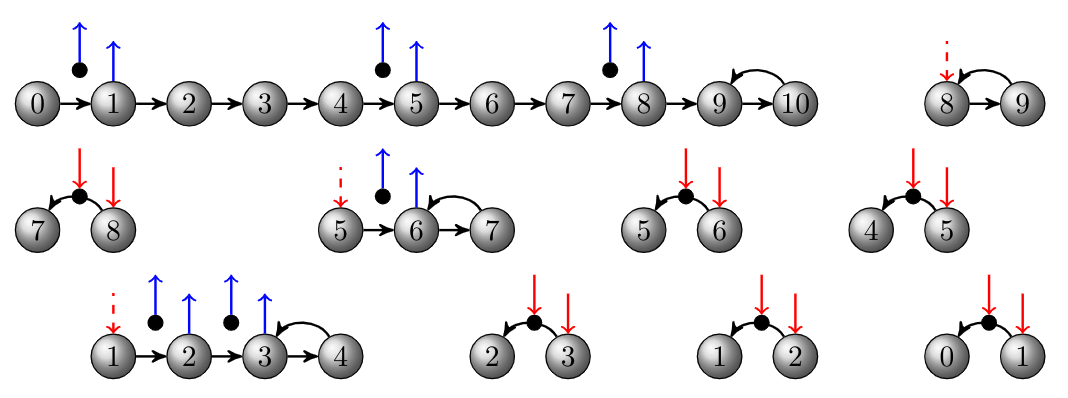This repository provides a neural ordinary differential equation (ODE) implementation using PyTorch and PETSc's discrete adjoint ODE solvers (TSAdjoint). The framework allows easy access to PETSc's time stepping algorithms, adjoint solvers and checkpointing algorithms. Switching between different algorithms can be simply done with command line options at runtime. All the examples are fully supported to run on the GPU with single or double precision.
petsc4py needs to be installed first. The suggested way to install petsc4py is to install it from PETSc source
git clone https://gitlab.com/petsc/petsc.git
cd petsc
./configure PETSC_ARCH=arch-linux-opt --with-debugging=0 --download-petsc4py
Here minimal configure options are provided. Several other widely used options are listed below:
--with-cude=1Use CUDA if an NVIDIA GPU is available.--with-fc=0Disable Fortran if you do not have a Fortran compiler or do not need Fortran.--with-precision=singleBuild PETSc with single precision (without his option, PETSc uses double precision). Note thatPETSC_ARCHtakes of your choice. One can create many different versions of PETSc, each of which can have a different list of options and be given a different name specified byPETSC_ARCH.
After configure, follow the instructions on screen to do make all and make check (optional).
After petsc4py is installed, install PNODE
git clone https://github.com/caidao22/pnode.git
cd pnode
pip3 install .
Examples are provided in the examples directory. They include:
examples/ode_demo_petsc.pySimplest example that demonstrate how to fit a spiral ODEexamples/train-Cifar10.pyImage classification on the CIFAR-10 datasetffjord-pnode/train_tabular.pyContinuous normalizing flow on the datasets from MAF
This library provides one class ODEPetsc with three interface functions:
setupTSsetup function for the solverodeint_adjointthe main interface function that solves a neural ODE and calculates the gradient with discrete adjoint methodsodeintgeneral-purpose ODE/DAE solver (without gradient calculation)
The API is similar to NODE and ANODE by design.
To solve an ODE in the form
du/dt = f(t, u) u(t_0) = u_0,
One needs to create an ODEPetsc object
from pnode import petsc_adjoint
ode = petsc_adjoint.ODEPetsc()
and then set up the solver with
ode.setupTS(u0, func, step_size=step_size, implicit_form=implicit_form, use_dlpack=use_dlpack)
where func is any callable implementing the ordinary differential equation f(t, u), u0 is an any-D Tensor or a tuple of any-D Tensors representing the initial values.
ode.odeint_adjoint(u0, t)
where t is a 1-D Tensor containing the evaluation points and t[0] is the initial time.
odeint_adjoint performs a forward sweep using the PETSc TS solver and a backward sweep using the PETSc TSAdjoint solver.
step_sizeStep size for time integration.methodOne of the solvers among 'euler', 'midpoint', 'rk4', 'dopri5_fixed'.enable_adjointSwitch for enabling or disabling the adjoint sweep.
These are just a few options for convenience. More PETSc settings can be used at runtime with command line options. For example, -ts_type cn will choose the Crank-Nicolson methods for time integration, and -ts_type rk -ts_rk_type 4 will choose the classic RK4 solver. For more details, we suggest reading the PETSc manual and the examples included.
PNODE offers a variety of optimal checkpointing strategies through the PETSc TSAdjoint library. For best efficiency, we suggest users to start from the following options
-ts_trajectory_type memory -ts_trajectory_solution_only 0
This will make PNODE store the solutions and stage values in DRAM at each time step in the forward sweep. If there is a limited memory budget, one can specify the maximum number of allowable checkpoints by adding an extra option -ts_trajectory_max_cps_ram <num_of_checkpoints>.
If you found this tool useful in your research, please consider citing.
@misc{Zhang2022pnode,
doi = {10.48550/ARXIV.2206.01298},
url = {https://arxiv.org/abs/2206.01298},
author = {Zhang, Hong and Zhao, Wenjun},
title = {{PNODE: A memory-efficient neural ODE framework based on high-level adjoint differentiation}},
publisher = {arXiv},
year = {2022},
}
@article{Zhang2022tsadjoint,
author = {Zhang, Hong and Constantinescu, Emil M. and Smith, Barry F.},
title = {{PETSc TSAdjoint: A Discrete Adjoint ODE Solver for First-Order and Second-Order Sensitivity Analysis}},
journal = {SIAM Journal on Scientific Computing},
volume = {44},
number = {1},
pages = {C1-C24},
year = {2022},
doi = {10.1137/21M140078X},
eprint = {https://doi.org/10.1137/21M140078X},
}
@misc{Zhang2022cams,
doi = {10.48550/arXiv.2202.11890},
url = {https://arxiv.org/abs/2202.11890},
title={{Optimal Checkpointing for Adjoint Multistage Time-stepping Schemes}},
author={Hong Zhang and Emil Constantinescu},
year={2022},
}
